7 Cool Facts About Cat Eye Colors
The post 7 Cool Facts About Cat Eye Colors by JaneA Kelley appeared first on Catster. Copying over entire articles infringes on copyright laws. You may not be aware of it, but all of these articles were assigned, contracted and paid for, so they aren't considered public domain. However, we appreciate that you like the article and would love it if you continued sharing just the first paragraph of an article, then linking out to the rest of the piece on Catster.com.
My cat Kissy had the most amazing eyes I’d ever seen: If I caught her with her eyes open on a sunny day, they were a beautiful sea-green that I could never capture in a photo. Most of the pictures I have of her, show her eyes with a golden tone. But whatever color your cat’s eyes are, there’s an amazing story behind how they got that way. Check out these cool facts on cat eye colors:
1. Cat eye colors start with the iris
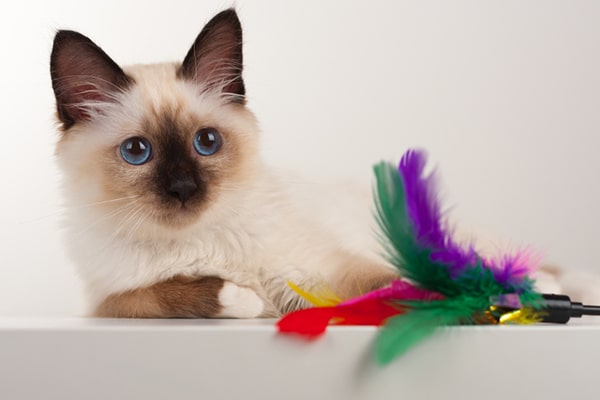
Cat eye colors start with the iris. Photography ©PatrikSlezak | Thinkstock.
When we talk about cat eye colors, we need to discuss the iris. The colored area around the pupil of the eye is called the iris. The iris has two layers, the stroma and the epithelium. Both of these layers contain pigment-producing cells called melanocytes. In the stroma, those melanocytes are loosely arranged, and in the epithelium, they are more tightly packed.
2. It’s all about melanin
An orange cat with copper eyes. Photography by FreeProd33 / Shutterstock.
The pigment produced by the melanocytes is called melanin. A while back I wrote an article on the genetics of cat fur color, in which I explained that melanin plays an important role in determining how dark your cat’s fur coat will be. The same thing is true with cat eye colors: The more melanocytes there are in your cat’s irises, the darker their color will be. But cats don’t get brown or black eyes like people do; the darkest color you’ll see in a cat’s eyes is a deep, rich copper.
3. A cat’s eye-color intensity is linked to melanocyte activity
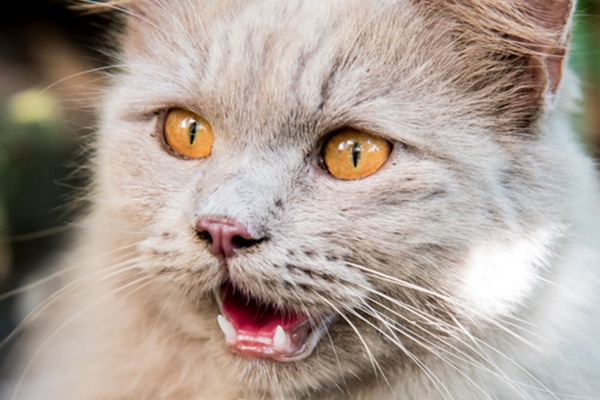
A cat with highly active melanocytes will have bright golden-yellow eyes. Photography ©graphixchon | Thinkstock.
When the melanin-producing cells are very active, cat eye colors will become more intense. For example, a cat with a medium amount of highly active melanocytes will have bright golden-yellow eyes, but a cat with a medium amount of less active melanocytes may have pale lemon-yellow eyes.
4. Purebred cats tend to have more intense eye colors
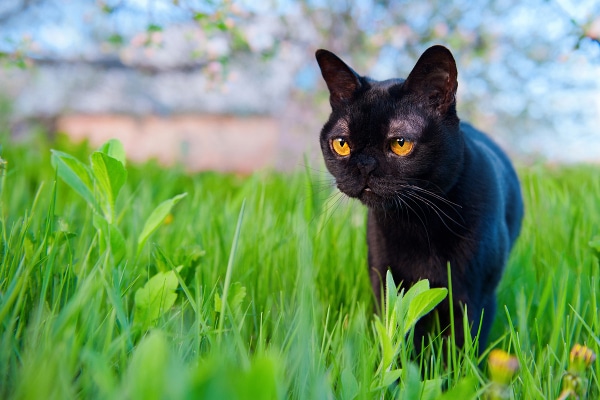
Bombay cat breed standards call for copper-colored eyes. Photography by Vecta / Shutterstock.
Because purebred cats are bred to meet a specific breed standard, which often includes eye color, breeders select for cats that have more intense colors or particular colors. For example, the Bombay cat breed standard requires copper-colored eyes; and the Tonkinese has aqua-colored eyes.
5. Blue-eyed cats have no melanin in their irises
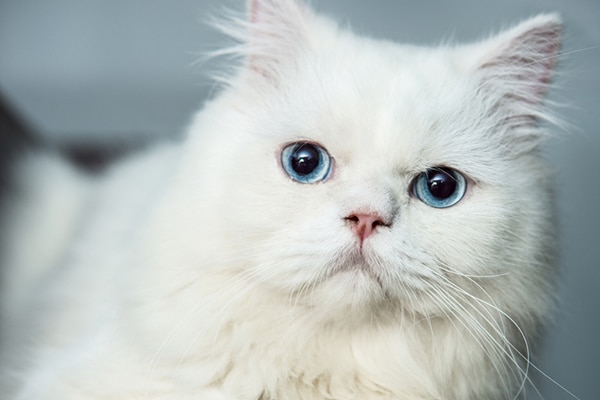
This blue-eyed white cat has no melanin in her fur or her eyes. Blue-eyed white Persian cat. Photography by DONOT6_STUDIO / Shutterstock.
You know how window glass looks clear when you look straight through it, but it looks kind of blue or green around the edges? That’s because of the refraction of light through a clear surface. The same thing happens with blue-eyed cats: They have no pigment cells in their irises, and because the eye has a rounded shape, light refracts through that rounded surface and produces the blue eye color in cats.
6. There’s a connection between melanin and kitten eyes, too
All kittens start off with blue eyes. Photography by ©w-ings | Getty Images
Kittens are born with blue eyes because their melanocytes haven’t started working yet. As they grow, their melanocytes start to function and the true color of their eyes begins to appear. The adult eye color starts to appear between 4 and 6 weeks of age, and a kitten’s true eye color is usually apparent by the time he or she is 4 months old.
7. There is generally little relation between fur colors and cat eye colors
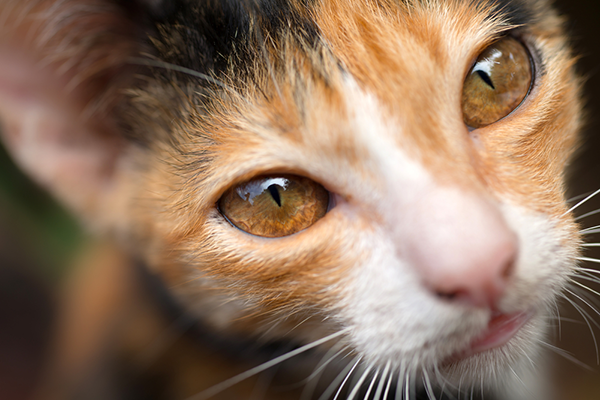
Do fur colors have anything to do with cat eye colors? Not really. Amber-eyed calico cat. Photography by iidea studio/ Shutterstock.
Different genes control fur colors and cat eye colors, so the melanocytes in the fur may be much more (or less) active than those in the eyes. Thus, a black cat like my Belladonna has pale hazel eyes, but a purebred orange Persian may have dark copper-colored eyes. The only exception to this rule is white cats. Because the epistatic white gene is a dominant and masks other colors, white cats are statistically more likely to have blue eyes than random-bred cats of other colors.
Tell us: Is there anything else you’d like to know about cat eye colors? Ask your questions in the comments!
Thumbnail: Photography by ANURAKE SINGTO-ON / Shutterstock.
This piece was originally published in 2017.
About the author
About JaneA Kelley: Punk-rock cat mom, science nerd, animal rescue volunteer and all-around geek with a passion for bad puns, intelligent conversation, and role-play adventure games. She gratefully and gracefully accepts her status as chief cat slave for her family of feline authors, who have been writing their award-winning cat advice blog, Paws and Effect, since 2003.
Read more about cats and science on Catster.com:
- 8 Interesting Facts About the Cat Nose and the Cat Sense of Smell
- Can Cats See in the Dark? The Answer to That and Other Cat Vision Questions
- Why Is Your Cat Drinking Water So Weird?
The post 7 Cool Facts About Cat Eye Colors by JaneA Kelley appeared first on Catster. Copying over entire articles infringes on copyright laws. You may not be aware of it, but all of these articles were assigned, contracted and paid for, so they aren't considered public domain. However, we appreciate that you like the article and would love it if you continued sharing just the first paragraph of an article, then linking out to the rest of the piece on Catster.com.




Post a Comment